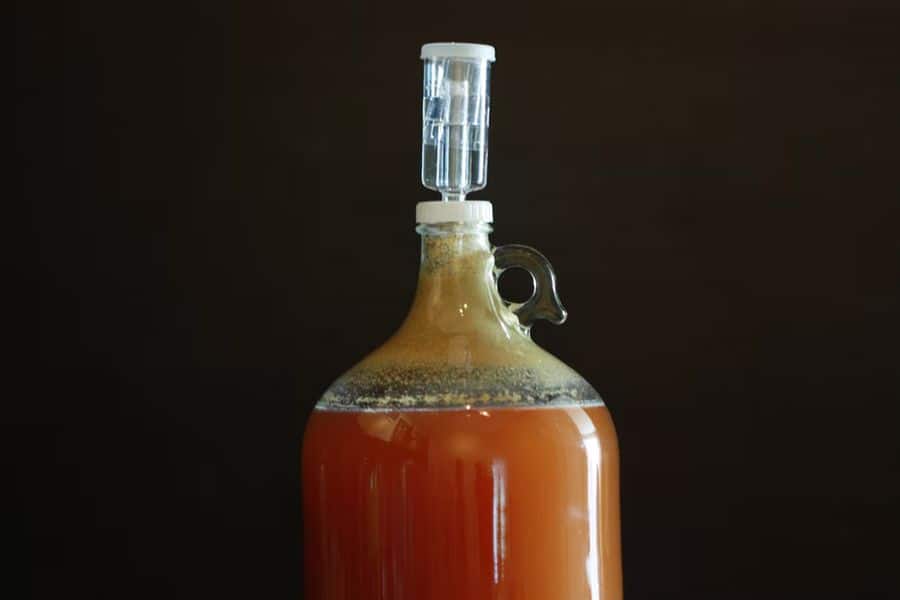If you buy something through a link in our posts, we may get a small share of the sale.
Sediments can sometimes form in homebrewed beer, particularly when bottle conditioning. They are very undesirable as they make the beer look cloudy and may leave an unpleasant taste in your mouth. Knowing how to pour homebrew without sediment is essential if you want to enjoy your beer at its best!
Contents
How to Pour Homebrew Without Sediment
To pour your beer without sediment, pour the beer slowly and carefully into a clean glass, leaving the last few drops in the bottom of the bottle. Then, gently swirl the beer in the glass to stir up any sediment that may have stuck to the side of the bottle.

It is also important that you do not pour too much beer into your glass at once. Otherwise, the beer will become too foamy, and the sediment will be more likely to be stirred up. Instead, pour a small amount of beer, then wait a few moments for the foam to settle before pouring more.
These are the immediate and short-term actions you can take to pour your homebrew beer without sediment. These methods will work for most sediments; however, if you find that your beer is still cloudy or has an off-flavor, there may be something else. It may be a sign that your beer did not look like it fermented properly or has a bacterial infection.
Steps in Settling and Removing Sediment in Beer
Getting rid of the sediment is an easy process that requires patience and a clear understanding of the brewing process. You don’t have to be a professional to get great-tasting, sediment-free beer. Here are the steps:
Allowing the Beer to Settle
This is one of the most important steps and often requires the most patience. After fermentation is complete and the beer has been transferred to a secondary fermenter or to beer bottles, it needs to sit and allow sediments to settle at the bottom. The length of this step will vary depending on factors such as gravity, temperature, and type of beer.
The general rule of thumb is to allow the beer to settle for two hours before you start pouring, although it could be longer. To check if the beer has settled enough, tilt your bottle or bucket at an angle and observe how quickly the sediments flow towards the side. If they quickly rush to one side, it means that they have not settled enough, and you will need to give it more time.
A good way to help the beer settle is to store it at a cool temperature, around 40 degrees Fahrenheit. The colder the beer, the faster it will settle.
Pouring Carefully
The moment has come for you to start pouring your beer into a glass. Take your time with this step and pour slowly, tilting the bottle or glass. You want to avoid pouring the sediments that have settled at the bottom of the container.
It is helpful to use a small funnel when transferring your beer from one container to another, such as from a bucket to a bottle or from the primary fermenter to the secondary fermenter. This will help you avoid pouring too much beer into your glass at once, which could cause the sediments to mix in with your beer.

Stirring up the Sediments
Once the beer has settled, it’s time to stir up any sediments that may have stuck to the glass. To do this, gently swirl the beer in your glass until you no longer see any sediments. You don’t have to go crazy; even the slightest swirl will do.
Methods of Settling and Removing Sediment in Beer
Now that you know the steps that involve the removal of sediments in beer, it’s time to learn about the different methods. Remember that the ideal method will depend on factors such as your process and equipment, and the type of beer you’re brewing.
The Cold Crash Method
The cold crash method is a popular sediment removal technique that both professional and amateur brewers use. This method requires storing your beer at around 32-35 degrees Fahrenheit to encourage the sediments to settle.
This method works best for beers stored in a keg or carboy. However, it can also be used for bottles and cans. The cold crash method is most effective when the beer is allowed to settle for 24-48 hours.
The main advantage of this method is that it is relatively easy to do and does not require any special equipment. The downside is that it can take a long time to settle, and you will need to have a kegerator or some other cold storage space.
The Racking Method
This is another popular method for removing sediments in beer, as it is relatively easy to do and does not require any special equipment. The racking method involves transferring your beer from one container to another, such as from the primary fermenter to the secondary fermenter or from the keg to a serving vessel.
When racking your beer, it is important to avoid the sediment at the bottom of your container. This means that you will need to rack slowly, using a tube or siphon to transfer the beer. You can also use a gravity-fed system, although this is not as effective.
The main advantage of the racking method is that it is relatively easy to do and does not require any specialized equipment. The downside is that if you are racking from a bucket or primary fermenter, the process might take a while.
The Centrifuge Method
This is a more advanced method that professional brewers typically use. The centrifuge method involves using a machine to spin the beer at high speed, separating the sediments from the beer.

This method is very effective for removing sediments and is often used for high-quality beers. It needs to be used in conjunction with other methods, such as the cold crash and racking methods. The main advantage of this method is that it can produce very clear beer. The downside is that it requires specialized equipment and can be expensive.
Factors Affecting Sediment Formation
In addition to knowing how to remove sediment from beer, it is also important to understand why it forms in the first place. Factors that can affect sediment formation include:
- The type of beer being brewed: Whether you’re making a strong beer or a dark beer. The ingredients, especially if they are expired or fresh, and the brewing process that was used can greatly affect the outcome of your beer.
- The amount of time that has passed since fermentation: the longer a beer sits, the more sediments will form naturally.
- Brewer’s practices, such as the temperatures, pH levels, and the age of the beer.
- The equipment that is used also plays an important role in sediment formation. It may be necessary to clean or replace certain parts of your brewing equipment if sediments are a problem.
Related Questions
Why Is There Sediment in My Homebrew?
The sediment results from the brewing process and is made up of yeast, proteins, and other solids. The yeast used during the fermentation process causes sediment to form.
Is Cloudy Homebrew Ok to Drink?
Yes, the cloudiness will not affect the flavor or quality of your homebrew, so it is ok to drink. However, some brewers choose to remove the sediments for aesthetic reasons.
How Do I Prevent Sediment From Forming in My Homebrew?
You can prevent sediment from forming by following the proper brewing processes, including ensuring that you are using high-quality ingredients and that your distilling equipment is clean and in good condition.
Conclusion
Sediment can be a natural by-product of the brewing process. However, it can make your beer appear cloudy and can affect the flavor. Using the correct techniques, you can remove the sediment from your homebrew without affecting the taste or quality and enjoy a clear beer.

